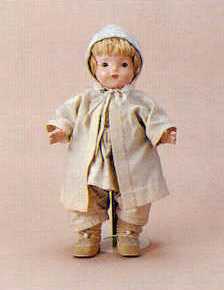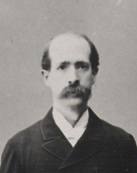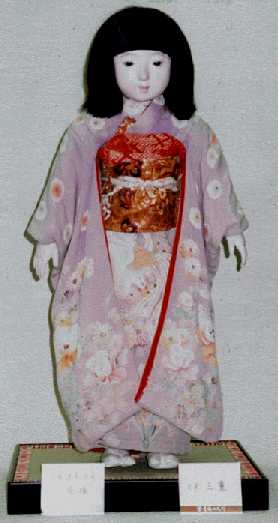"My grandfather worked for 25 years as a missionary in Japan," says Sidney L. Gulick 3rd, from his home in Maryland. "He wanted to be the best missionary he could be, not only in his teaching but in his communication with the Japanese. To that end he committed himself to studying the Japanese language. Her learned to speak fluently, and even wrote several books in Japanese. "Poor health forced him to return to America in 1913, but his affection for Japan was so strong that he continued to write and lecture about the country for many years after he had left. He hoped that by doing so he might help to minimize the tensions what were building between the two countries and bring about a relaxation of the United States' very hurtful immigration laws. The laws were passed as early as 1907 and culminated in the Immigration Act of 1924, which effectively barred Japanese from entering the US until 1952, when the McCarran-Walter Act was passed. He later wrote that in America 'I am as truly a missionary working for Japan as if I were in Japan.' "In time he decided that the best way to foster peace in the future was through the young. In fact, he wrote, 'We who desire peace must write it in the hearts of children.'"
It was not until the mid-1980s, when his father (Sidney L. Gulick, Jr.) was in his eighties and in frail health, that Gulick first heard of the "Friendship Dolls." He believes his family's reluctance to discuss his grandfather's activities in that period was linked to his wartime reputation as a Japanese sympathizer; some had even thought him a spy. There were Japanese in the 1980s who knew more about Lewis's ancestors than he did. Hironori Ohto of the Friends of the Yokohama Foreign Cemetery is one of them. He is a font of information about the 19 Gulicks who have lived and worked in Japan. "The Reverend Dr. Gulick's younger brother, Luther Halsey Gulick, Jr., invented and spread the game of basketball," Ohto asserts. "He also designed the YMCA's triangle logo. Dr. Gulick's son, Sidney L. Gulick, Jr., was a famous champion of academic and press freedom during the McCarthy era... Dr. Gulick's ashes were entombed in three places: alongside his father's in Springfield, Massachusetts; in Boise, Idaho; and in Kobe." And what of the Friendship Dolls? Says Ohto, "To understand the story of the Friendship Dolls you need to know a little bit about the US Immigration Act of 1924, but mainly you need to be aware that the Reverend Dr. Sidney L. Gulick was the sort of person who believed that whatever discord there might be between nations, citizens will strive to conquer it and make friends."
As a long-time resident of Japan, Dr. Gulick was familiar with Japanese customs, and certainly knew of the Hina Matsuri--the annual doll festival for girls. He also knew how much Japanese children treasure dolls, and would likely have known by heart the perennially popular children's song, "A Blue-eyed Doll." Inspired by this, Dr. Gulick decided to incorporate dolls in a "Mission of Friendship." With the help of the Federal Council of Churches in America, Dr. Gulick founded the Committee on World Friendship Among Children and began collecting dolls from children around the US. It is estimated that some 2.6 million children knew of this project to send dolls to Japan for the doll festival.To facilitate the dolls' entry into and distribution around Japan, Gulick contacted Eiichi Shibusawa, then president of the America-Japan Society. Shibusawa was another man saddened by the deteriorating US-Japan relations, and, impressed by Gulick's plan, he sought support from the Japanese Ministries of Foreign Affairs and Education to found the Japanese Committee on International Friendship Among Children. By their deadline in November of 1926, Gulick's Committee had collected 12,739 dolls. To each doll they attached a message: "May the United States of America and Japan always stay friends. I am being sent to Japan on a mission of friendship. Please let me join the doll festival on March 3 in your country." The dolls also carried a passport, which read: "This doll is a good citizen of the United States of America. She will obey all the laws and customs of your country. Please take care of her while she is with you." The Friendship Dolls arrived at the port of Yokohama in January 1927 and toured the country before being distributed to schools and kindergartens around Japan and its colonies. For the children who received them, the American dolls, with their blonde hair, blue eyes, and otherwise different appearances were an unforgettable surprise. Says Gulick, "The Mission of Friendship was a wonderful effort to foster mutual understanding between Japan and the US. Not only did the dolls carry some of the culture of America, but they were accompanied by feelings of goodwill and internationalism. The Friendship Dolls were sent by innocent and friendly children, both individually and in groups, who wished to stretch out their hands in understanding and appreciation across the ocean. "The fact that the governments of the two countries misunderstood each other's motives did not reduce the power of the dolls' message. I know of a number of Japanese who vividly remember the day the Friendship Doll arrived at their schools, now almost 70 years ago! My own feeling is that the doll mission my grandfather inaugurated was perhaps the most important and enduring accomplishment of his long life."
Knowing that the Japanese would want to reciprocate the American gesture, Sidney L. Gulick wrote to Shibusawa urging him not to worry about sending return dolls. Inevitably, the Japanese sent the dolls anyway. Because of economic constraints and the limited time for preparation--the Japanese Committee planned to send the dolls in time for Christmas that same year--it was decided that a limited number of 58 (the sum of the prefectures, colonies, six main cities, and the state of Japan) high-quality Japanese dolls would be crafted. To fund the project, the Committee collected one sen each from over 2 million children whose schools had received a Friendship Doll.
Tokubei Yamada 10th, president of the Tokyo doll manufacturer and wholesaler Yoshitoku Dolls, played a leading role in organizing the crafting of those dolls. His son and the current president of Yoshitoku Dolls, Tokubei Yamada 11th, says, "My father told me all about those dolls. He says that at that time the country was in mourning for Emperor Taisho, who passed away on December 25, 1926, so the news that about 13,000 American dolls would participate in the Hina Matsuri was cheering news for everyone, not least for the doll manufacturing industry. The industry only survived, he says, because of the opportunities to provide new sets of dolls for this now special doll festival and to compete for the chance to craft one of the dolls to be sent to America. "Almost 100 Tokyo craftsmen and their apprentices competed to make those 51 superior dolls--the order for the seven other dolls went to Kyoto. The dolls were to be of the Ichimatsu-type [said to resemble Sanogawa Ichimatsu, a popular 17th century Kabuki actor; the dolls have flexible hip, knee, and ankle joints] and to stand 81 centimeters tall. The dolls were made considerably larger than usual because, it was felt, the number to be sent was small, relative to the number received from America; it was their way of striking a balance." The winning dolls were each valued at 350 yen. In those days, a university graduate could expect a first monthly salary of 50 yen, or 200,000 yen ($2,400) today, so they were a real extravagance. They even wore underwear and tabi socks. "Japanese dolls did not ordinarily wear underwear or tabi." Yamada says, "but the 'Ambassador Dolls' did because, it was rationalized, they were making official visits." In November 1927, the 58 dolls left for the US from the port of Yokohama. Each bore the prefix Miss before the name of her representative prefecture, city, or colony. Miss Japan also went by the name Hideko Yamato. The dolls bore a passport and a message of friendship handwritten by Japanese children. Welcoming parties greeted the dolls at each US port of call. In all, more than 1,000 welcoming parties at 479 cities were held for the 58 Ambassador Dolls. At the welcoming party in Washington, D.C., Japanese Ambassador to the US, Tsuneo Matsudaira, said, "I am particularly delighted to welcome them, because from now on I shall have no less than 58 fellow ambassadors to assist me. They can do what I cannot… These dolls are silent, they do not talk, but sometimes silence is more eloquent than speech. When one's heart is filled with emotion, one often loses the power to speak. These dolls silently but eloquently tell you of the friendly feelings which the children of Japan entertain for the children of America." Mrs. Peabody, who presided over the party, said in reply, "A hundred years from now, when wars have ceased and nations live together as friends and brothers, our children and our great-grandchildren will look back to this day when the children of our two nations sealed a bond of friendship through the gifts which have come to us from your little children." The dolls were then placed on exhibition in museums and galleries around the country. Miss Japan found a home at the National Museum of Natural History in Washington, D.C. In December 1941, war separated Japan and the US in mutual enmity, and the dolls were among its victims. Large numbers of Friendship Dolls were deliberately destroyed in Japan, and most of the Ambassador Dolls were put in storage in the US, with some (23) still to be recovered. Excitingly, though, Friendship Dolls are starting to turn up again. Eiko Takeda, a writer and president of the Association of Friendship Exchanges of Blue-eyed Dolls (established in 1988), is one of those who has been instrumental in searching them out. Takeda became interested in the dolls when she saw a television news item in 1973 which related the resurfacing of one of the dolls. She has since written several books on the Friendship Dolls. "The dolls reflect the history of the relationship between Japan and the US," says Takeda. "They symbolize in a way the countries' transitions between friendship and hatred. My research into the dolls has really been research into the history of the Showa Period (1926-1989). "During the war, people were emotionally charged with hatred for the US and the UK, and the Friendship Dolls were a natural target for that hatred. It must have been very difficult to resist those feelings, yet many Japanese clearly found the sight of the dolls being smashed up or burned unbearable. The large number of dolls that survived is testimony to the great courage some people had in preserving them." Sumie Kobayashi, the elder sister of Yamada and curator of Yoshitoku Dolls Data Center, says, "The Japanese have a special attachment to dolls: they empathize with and personify them. Whereas in America the Japanese dolls were seen essentially as works of art, the American dolls in Japan became objects of hate because the Japanese personified their country's feelings of antagonism for America in them." Little is known of what happened to the Ambassador Dolls during the war, although one story has come to light. In 1942, at the North Carolina State Museum of Natural History, there was a sign beside the Miss Kagawa doll, which had been turned to face the wall. Under the title "Whom the gods would destroy they first make mad," the sign read. "The Japanese made an insane attack upon American Territory of Hawaii on December 7, 1941. With a grim determination we now are committed to stop for all time Japanese aggression. Thais has no bloodthirsty implications to destroy peoples as such. We still believe in peace and goodwill to live and let live. Men, women, and children of Japan have this good-will but they have now been dominated by ruthless leaders. Proof of such latent goodwill are the Friendship Doll Exhibits exchanged between children of the United States and Japan during 1926 and 1927 and shown as here in museums in both countries."
The search for the Friendship and Ambassador Dolls has intensified since around 1973. Thanks to the efforts of Hironori Ohto and his group and Eiko Takeda and her association, 270 American dolls and 35 Japanese dolls in the US have been located. Over time, beginning with the Miss Hiroshima doll in 1974, a number of Japanese dolls have returned to Japan for repairs and exhibition, and a variety of events have been held. The rehabilitation of returning dolls has mainly been carried out by the Yoshitoku company. President Yamada says, "the dolls 'cry' when you push their chests because whistles were inserted there. So when we first undress a doll on her return, she seems to cry, and freed at last from her tight-fitting kimono, she seems to relax and stretch." In 1986, Gulick and his wife Frances attended the opening ceremony of the Yokohama Doll Museum. While in Japan they visited an elementary school in Kyoto, which has one of the Friendship Dolls sent in 1927, and presented it with a new pair of dolls, a boy and a girl. Says Gulick, 3rd, "By the expressions of excitement and love on the faces of the children as they received and held the new dolls, we knew immediately that we should begin a new doll mission." Since 1986 the couple has sent approximately 10 dolls each year to schools in Japan. Frances Gulick, who like her husband is a professor of mathematics at the University of Maryland, makes traveling clothes, a nightgown, and a handbag for each doll. Her husband prepares the passport and a letter of introduction. Together they make sure the dolls arrive in time for the Hina Matsuri. "Now, a time when again there in tension between Japan and the US, we feel it is all the more important to promote international understanding," says Gulick. "We feel the same way that Ambassador Matsudaira felt nearly 70 years ago." The Gulicks are not the only people using dolls to promote peace and understanding. Terry Hiener, research associate at the Carnegie Museum in Pittsburgh, Pennsylvania, which is home to the Miss Kochi doll, is another. Hiener has recently founded an organization called Friendship Ambassadors, promoting mutual understanding through lectures and exhibits. Hiener travels to schools in and around Pittsburgh, discussing the doll missions and describing the culture of Japan through dolls. Michiko Takaoka also became interested in sending Japanese dolls. She read that while Gulick receives many letters each year from Japanese schoolchildren requesting American dolls, there had been no proposal to send Japanese dolls to the US. "I thought, 'Then I will do that,'" she says. Takaoka, who is director of the Japanese Cultural Center at the Mukogawa Fort Wright Institute in Spokane, Washington, organizes the dispatch of some 50 sets of Japanese dolls each year, and through the Center distributes them to schools in the US. On March 3, 1992, Takaoka organized a Doll Festival at Cheney Cowles Museum in Spokane, where the Miss Tokushima doll had been carefully preserved. She wanted to share the heartwarming history of the Ambassador Dolls with the students of the Institute, and to express her appreciation to the townspeople and the museum for having looked after Miss Tokushima. Takaoka initiated the Friendship Doll Program in the fall of 1992, backed by the Institute's president, Akira Kusaka, and its mother educational institute, Mukogawa Gakuin in Hyogo. The program raises money to buy and send Japanese dolls to American children. Through its annual Doll Festival, the program has also collected over 200 sets of dolls and donated them to elementary schools, community centers, libraries, and children's museums in the US. Up to now Takaoka has met 16 of the Japanese Ambassador Dolls that were sent to the US all those years ago. Whenever she meets one, she says, she feels that they have been waiting for her. Takaoka wants to meet as many as possible. "Americans are very familiar with what Japan manufactures," says Takaoka, "but I want them to know about what the country feels. I started this movement to spread the word of friendship and good faith in the honest hearts of the children." The Reverend Dr. Sidney L. Gulick had a great idea, and his dream lives on. |
Article reprinted with permission of author and
publisher.
Photos used with permission.


